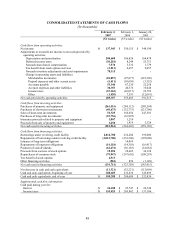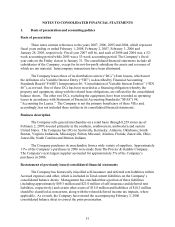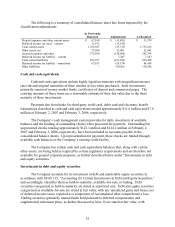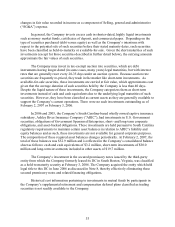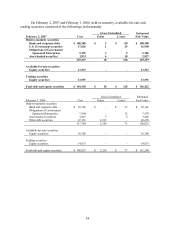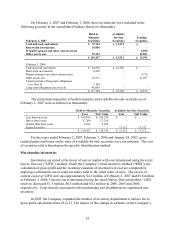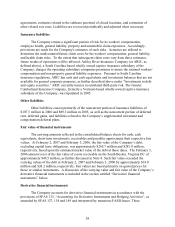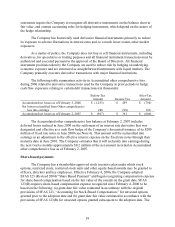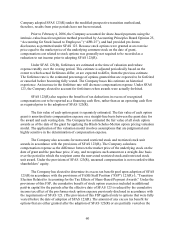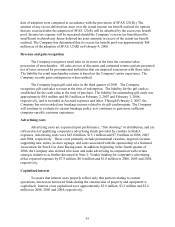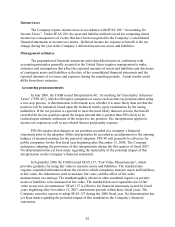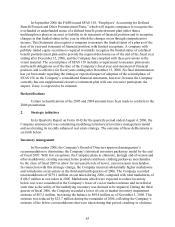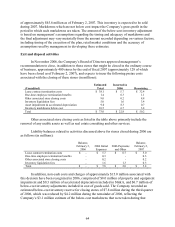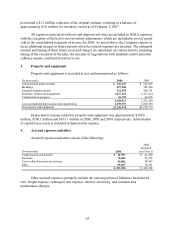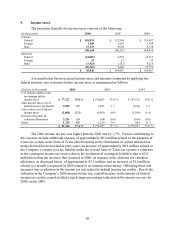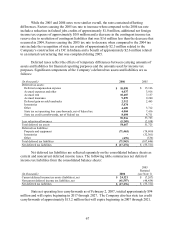Dollar General 2006 Annual Report Download - page 61
Download and view the complete annual report
Please find page 61 of the 2006 Dollar General annual report below. You can navigate through the pages in the report by either clicking on the pages listed below, or by using the keyword search tool below to find specific information within the annual report.
statements require the Company to recognize all derivative instruments on the balance sheet at
fair value, and contain accounting rules for hedging instruments, which depend on the nature of
the hedge relationship.
The Company has historically used derivative financial instruments primarily to reduce
its exposure to adverse fluctuations in interest rates and, to a much lesser extent, other market
exposures.
As a matter of policy, the Company does not buy or sell financial instruments, including
derivatives, for speculative or trading purposes and all financial instrument transactions must be
authorized and executed pursuant to the approval of the Board of Directors. All financial
instrument positions taken by the Company are used to reduce risk by hedging an underlying
economic exposure and are structured as straightforward instruments with liquid markets. The
Company primarily executes derivative transactions with major financial institutions.
The following table summarizes activity in Accumulated other comprehensive loss
during 2006 related to derivative transactions used by the Company in prior periods to hedge
cash flow exposures relating to certain debt transactions (in thousands):
Before-Tax
Amount Income Tax
After-Tax
Amount
Accumulated net losses as of February 3, 2006 $ (1,253) $ 459 $ (794)
Net losses reclassified from Other comprehensive
loss into earnings 286 (98) 188
Accumulated net losses as of February 2, 2007 $ (967) $ 361 $ (606)
The Accumulated other comprehensive loss balance at February 2, 2007 includes
deferred losses realized in June 2000 on the settlement of an interest rate derivative that was
designated and effective as a cash flow hedge of the Company’ s forecasted issuance of its $200
million of fixed rate notes in June 2000 (see Note 6). This amount will be reclassified into
earnings as an adjustment to the effective interest expense on the fixed rate notes through their
maturity date in June 2010. The Company estimates that it will reclassify into earnings during
the next twelve months approximately $0.2 million of the net amount recorded in Accumulated
other comprehensive loss as of February 2, 2007.
Share-based payments
The Company has a shareholder-approved stock incentive plan under which stock
options, restricted stock, restricted stock units and other equity-based awards may be granted to
officers, directors and key employees. Effective February 4, 2006, the Company adopted
SFAS 123 (Revised 2004) “Share Based Payment” and began recognizing compensation expense
for share-based compensation based on the fair value of the awards on the grant date. SFAS
123(R) requires share-based compensation expense recognized since February 4, 2006 to be
based on the following: (a) grant date fair value estimated in accordance with the original
provisions of SFAS 123, “Accounting for Stock-Based Compensation,” for unvested options
granted prior to the adoption date and (b) grant date fair value estimated in accordance with the
provisions of SFAS 123(R) for unvested options granted subsequent to the adoption date. The
59


